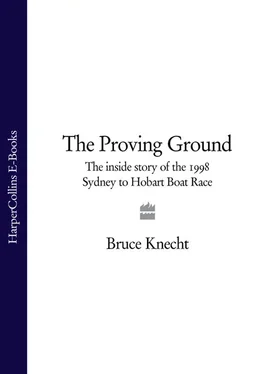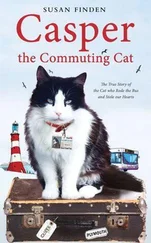THE PROVING GROUND
The Story of the Disastrous Sydney to Hobart Boat Race 1998
G. BRUCE KNECHT
Fourth Estate
A Division of HarperCollins Publishers 1 London Bridge Street London SE1 9GF
www.harpercollins.co.uk
This paperback edition first published in 2002
First published in Great Britain in 2001 by Fourth Estate
Copyright © G. Bruce Knecht 2001
The right of G. Bruce Knecht to be identified as the author of this work has been asserted by him in accordance with the Copyright, Designs and Patents Act 1988
A catalogue record for this book is available from the British Library
All rights reserved under International and Pan-American Copyright Conventions. By payment of the required fees, you have been granted the nonexclusive, nontransferable right to access and read the text of this ebook on screen. No part of this text may be reproduced, transmitted, downloaded, decompiled, reverse engineered, or stored in or introduced into any information storage and retrieval system, in any form or by any means, whether electronic or mechanical, now known or hereinafter invented, without the express written permission of HarperCollins e-books.
HarperCollins Publishers has made every reasonable effort to ensure that any picture content and written content in this ebook has been included or removed in accordance with the contractual and technological constraints in operation at the time of publication.
Source ISBN: 9780007292080
Ebook Edition © MARCH 2016 ISBN: 9780007392544
Version: 2016-01-29
For Elizabeth

COVER
TITLE PAGE
COPYRIGHT
DEDICATION
MAP
PROLOGUE
PART I: THE CALM
1
2
3
4
5
6
7
8
9
PART II: EAST OF EDEN
10
11
12
13
14
15
16
17
PART III: THE BLACK CLOUD
18
19
20
21
22
23
24
25
26
27
PART IV: ADRIFT
28
29
30
31
32
33
34
35
PART V: WAKE
36
37
38
EPILOGUE
ACKNOWLEDGMENTS
ABOUT THE PUBLISHER
LARRY ELLISON WAS lying in his bunk, calculating the likelihood that he would die.
He was, thanks to his stock in his company, Oracle, one of the wealthiest men in the world. But right now, he was seasick and miserable, and the NASDAQ seemed very far away.
One day earlier, he had seen what was coming. Looking at one of the two laptop computers used on his boat, he saw a satellite-generated image of a cyclone-like cloud pattern. Gripped with the same surreal feeling of disconnectedness he sometimes had when he was flying a plane on instruments, he asked Mark Rudiger, the yacht’s navigator, “Have you ever seen anything like this?”
Almost imperceptibly, Rudiger shook his head.
“Well, I have,” Ellison declared, his voice rising in bewildered outrage. “It was on the Weather Channel—and it was called Hurricane Helen. What the fuck is that doing here?”
Ellison’s yacht Sayonara had been struggling ever since. Steep forty-foot waves were sucking Sayonara up terrifying crests and then releasing it into deep troughs. Going up felt like riding an elevator during an earthquake; going down felt as though the elevator’s cable had snapped. The boat’s hull was made from two skins of carbon fiber surrounding a core of foam. Carbon fiber is a synthetic material with incredible strength for its weight, but Ellison knew that structural elements were beginning to fail. Several of the bulkheads, critical to maintaining the integrity of the hull, were no longer even attached. Large oval blisters had developed on the hull’s inside surface near the bow, indicating that the carbon skin had separated from the foam interior and that the two surfaces were grating against each other. Ellison knew that at some point the hull would become so weak that it would collapse like a paper bag against one of the waves. He also knew that Sayonara was too far out at sea to be reached by helicopter and that if he ended up in the water, he was unlikely to survive long enough to be rescued by another vessel.
By every standard but his own, Ellison, who looked younger than his fifty-four years, lived the life of dreams. On most days, he directed his company of 37,000 employees without even showing up at the office. He preferred to keep in touch by phone and e-mail from Katana , his 240-foot power yacht, or from his elegantly simple Japanese-style house in Atherton, California, where a pond was filtered like a swimming pool to ensure that the water was always crystal clear.
But Ellison was motivated by a kind of deeply rooted ambition that would never be satisfied. He was born to an unwed mother who gave him up for adoption. His adoptive father repeatedly told him he would never amount to anything. Since then, Ellison’s successes had only expanded his appetites. Although he carried himself with the bouncy manner of an adolescent who has just won an athletic championship, his dark brown eyes appeared coldly focused and constantly calculating. In a rarefied form of keeping up with the Joneses, much of the calculus involved his greatest rival, Microsoft’s Bill Gates. It was a rivalry that, in Ellison’s mind at least, went far beyond business and money. Ellison, who wrote short stories, played the piano, and piloted stunt planes in addition to winning sailing regattas, was constantly seeking to portray himself as more talented and more broadly gauged than Gates.
To Ellison, life was an experiment, or a contest, with a singular purpose: determining just how good he could be. Speed was an overriding theme. In addition to Sayonara , Ellison had a collection of high-performance planes and cars. With its 18,500-horsepower engine, Katana could charge through the water at thirty-five miles an hour. Ellison had given a lot of thought to his endless quest to go fast. “There are two aspects of speed,” he told friends. “One is the absolute notion of speed. Then there’s the relative notion—trying to go faster than the next guy. I think it’s the latter that is much more interesting. It’s an expression of our primal being. Ever since we were living in villages as hunter-gatherers, great rewards went to people who were stronger, faster.”
Ellison had entered the Sydney to Hobart Race because it is one of sailing’s most challenging contests. The danger had been part of the appeal. But as he lay in his bunk and looked around the cabin, where some of the world’s best sailors were lying on heaps of wet sails and retching into buckets, he was having second thoughts about his compulsive need to win.
Sayonara burrowed deep into each oncoming wall of water. Then, as if remembering it was supposed to float, it bobbed straight up to the wave’s crest. At that point Ellison began to count—“one one thousand, two one thousand”—as the bow projected out of the wave’s other side, again seeming to defy the natural order of things, until such a large section of the seventy-nine-foot vessel was hanging freely that gravity brought it down. That motion seemed to continue forever, although he had only reached “four one thousand” when the cycle ended with a violent crash.
This, he kept saying to himself, would be a stupid way to die.
Читать дальше













